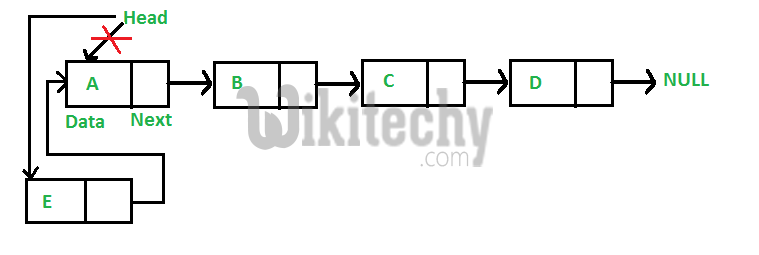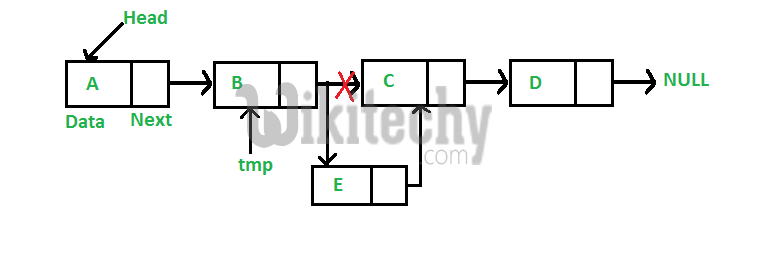We have introduced Linked Lists in the previous post. We also created a simple linked list with 3 nodes and discussed linked list traversal.
All programs discussed in this post consider following representations of linked list
Python Programming:
# Node class
class Node:
# Function to initialize the node object
def __init__(self, data):
self.data = data # Assign data
self.next = None # Initialize next as null
# Linked List class
class LinkedList:
# Function to initialize the Linked List object
def __init__(self):
self.head = None
In this post, methods to insert a new node in linked list are discussed. A node can be added in three ways
1) At the front of the linked list
2) After a given node.
3) At the end of the linked list.
[ad type=”banner”]
Add a node at the front: (A 4 steps process)
The new node is always added before the head of the given Linked List. And newly added node becomes the new head of the Linked List. For example if the given Linked List is 10->15->20->25 and we add an item 5 at the front, then the Linked List becomes 5->10->15->20->25. Let us call the function that adds at the front of the list is push(). The push() must receive a pointer to the head pointer, because push must change the head pointer to point to the new node (See this)

Following are the 4 steps to add node at the front.
Python Programming:
# This function is in LinkedList class
# Function to insert a new node at the beginning
def push(self, new_data):
# 1 & 2: Allocate the Node &
# Put in the data
new_node = Node(new_data)
# 3. Make next of new Node as head
new_node.next = self.head
# 4. Move the head to point to new Node
self.head = new_node
Time complexity of push() is O(1) as it does constant amount of work.
[ad type=”banner”]
Add a node after a given node: (5 steps process)
We are given pointer to a node, and the new node is inserted after the given node.

Python Programming:
# This function is in LinkedList class.
# Inserts a new node after the given prev_node. This method is
# defined inside LinkedList class shown above */
def insertAfter(self, prev_node, new_data):
# 1. check if the given prev_node exists
if prev_node is None:
print "The given previous node must inLinkedList."
return
# 2. Create new node &
# 3. Put in the data
new_node = Node(new_data)
# 4. Make next of new Node as next of prev_node
new_node.next = prev_node.next
# 5. make next of prev_node as new_node
prev_node.next = new_node
Time complexity of insertAfter() is O(1) as it does constant amount of work.
Add a node at the end: (6 steps process)
The new node is always added after the last node of the given Linked List. For example if the given Linked List is 5->10->15->20->25 and we add an item 30 at the end, then the Linked List becomes 5->10->15->20->25->30.
Since a Linked List is typically represented by the head of it, we have to traverse the list till end and then change the next of last node to new node.

Following are the 6 steps to add node at the end
Python Programming:
# This function is defined in Linked List class
# Appends a new node at the end. This method is
# defined inside LinkedList class shown above */
def append(self, new_data):
# 1. Create a new node
# 2. Put in the data
# 3. Set next as None
new_node = Node(new_data)
# 4. If the Linked List is empty, then make the
# new node as head
if self.head is None:
self.head = new_node
return
# 5. Else traverse till the last node
last = self.head
while (last.next):
last = last.next
# 6. Change the next of last node
last.next = new_node
Time complexity of append is O(n) where n is the number of nodes in linked list. Since there is a loop from head to end, the function does O(n) work.
This method can also be optimized to work in O(1) by keeping an extra pointer to tail of linked list
[ad type=”banner”]
Following is a complete program that uses all of the above methods to create a linked list.
Python Programming:
# A complete working Python program to demonstrate all
# insertion methods of linked list
# Node class
class Node:
# Function to initialise the node object
def __init__(self, data):
self.data = data # Assign data
self.next = None # Initialize next as null
# Linked List class contains a Node object
class LinkedList:
# Function to initialize head
def __init__(self):
self.head = None
# Functio to insert a new node at the beginning
def push(self, new_data):
# 1 & 2: Allocate the Node &
# Put in the data
new_node = Node(new_data)
# 3. Make next of new Node as head
new_node.next = self.head
# 4. Move the head to point to new Node
self.head = new_node
# This function is in LinkedList class. Inserts a
# new node after the given prev_node. This method is
# defined inside LinkedList class shown above */
def insertAfter(self, prev_node, new_data):
# 1. check if the given prev_node exists
if prev_node is None:
print "The given previous node must inLinkedList."
return
# 2. create new node &
# Put in the data
new_node = Node(new_data)
# 4. Make next of new Node as next of prev_node
new_node.next = prev_node.next
# 5. make next of prev_node as new_node
prev_node.next = new_node
# This function is defined in Linked List class
# Appends a new node at the end. This method is
# defined inside LinkedList class shown above */
def append(self, new_data):
# 1. Create a new node
# 2. Put in the data
# 3. Set next as None
new_node = Node(new_data)
# 4. If the Linked List is empty, then make the
# new node as head
if self.head is None:
self.head = new_node
return
# 5. Else traverse till the last node
last = self.head
while (last.next):
last = last.next
# 6. Change the next of last node
last.next = new_node
# Utility function to print the linked list
def printList(self):
temp = self.head
while (temp):
print temp.data,
temp = temp.next
# Code execution starts here
if __name__=='__main__':
# Start with the empty list
llist = LinkedList()
# Insert 6. So linked list becomes 6->None
llist.append(6)
# Insert 7 at the beginning. So linked list becomes 7->6->None
llist.push(7);
# Insert 1 at the beginning. So linked list becomes 1->7->6->None
llist.push(1);
# Insert 4 at the end. So linked list becomes 1->7->6->4->None
llist.append(4)
# Insert 8, after 7. So linked list becomes 1 -> 7-> 8-> 6-> 4-> None
llist.insertAfter(llist.head.next, 8)
print 'Created linked list is:',
llist.printList()
# This code is contributed by Manikantan Narasimhan
Output:
Created Linked list is: 1 7 8 6 4


